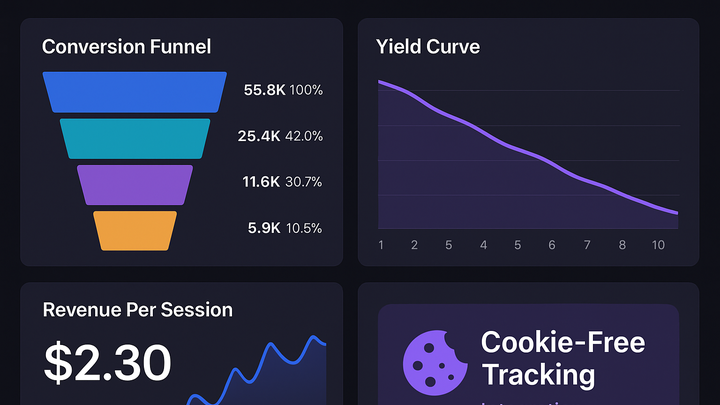Published on 2025-06-26T05:25:49Z
What is Yield Management? Examples in Analytics
Yield Management is a data-driven strategy that optimizes the ratio of desired outcomes (like purchases or sign-ups) to total traffic. Originally developed in the airline and hospitality industries, it dynamically adjusts prices and offers based on demand, inventory constraints, and customer behavior. In digital analytics, yield management applies these same principles to website and app performance, focusing on metrics such as conversion rates and revenue per session. By leveraging analytics platforms like Google Analytics 4 (GA4) and privacy-focused tools like PlainSignal, businesses gain real-time insights into high-yield user segments. With cookie-free tracking from PlainSignal, you can ensure compliance with privacy regulations while still capturing critical yield metrics. Ultimately, yield management in analytics enables brands to make informed decisions that maximize revenue, improve resource utilization, and enhance customer satisfaction.
Yield management
Yield Management in analytics is the strategic use of data to optimize conversion rates and revenue per session.
Definition and Context
Explain the origins of yield management in traditional industries like airlines and hospitality, and how the principles apply to digital analytics for websites and apps.
-
Historical origins
Yield management originated in the 1970s airline industry to adjust prices based on demand forecasts and inventory perishable capacity.
-
Application in digital analytics
In analytics, yield management focuses on measuring and optimizing the ratio of desired outcomes (conversions) to overall traffic, maximizing revenue per interaction.
Why Yield Management Matters
Discuss the business impact and strategic value of yield management in maximizing revenue and improving resource utilization.
-
Revenue optimization
Dynamic adjustments in pricing or promotional offers increase average order values and overall profitability.
-
Improved conversion rates
By focusing on higher-yield customer segments and optimizing funnel steps, businesses can boost the percentage of visitors who convert.
-
Resource utilization
Balancing supply and demand ensures that digital and physical resources are used efficiently without excess capacity or stockouts.
Implementing Yield Management with Analytics Tools
Practical steps to measure and optimize yield using popular analytics platforms like GA4 and PlainSignal.
-
Key metrics to track
Define the critical metrics that reflect yield and revenue efficiency.
-
Conversion rate
The percentage of sessions that result in a purchase or other valued action.
-
Revenue per session
Total revenue divided by the number of sessions to gauge earning efficiency.
-
-
Setting up GA4
Configure Google Analytics 4 to capture events and generate custom funnel reports.
-
Event configuration
Set up purchase events and micro-conversion events using gtag.js or the GA4 interface.
-
Custom reports
Use Explorations or funnel analysis to visualize yield at each step of the user journey.
-
-
Setting up PlainSignal
Leverage a cookie-free analytics tool for privacy-friendly yield tracking.
-
Install tracking code
Include the following snippet in your site’s <head> section:
<link rel="preconnect" href="//eu.plainsignal.com/" crossorigin /><script defer data-do="yourwebsitedomain.com" data-id="0GQV1xmtzQQ" data-api="//eu.plainsignal.com" src="//cdn.plainsignal.com/plainsignal-min.js"></script> -
Configure parameters
Use
data-dofor domain anddata-idfor your site ID to ensure accurate data capture.
-
Best Practices and Common Pitfalls
Recommendations for effective yield management and warnings about common mistakes.
-
Regular a/b testing
Continuously test different pricing, messaging, and funnel flows to identify high-yield strategies.
-
Avoid data silos
Ensure integration of analytics data with CRM and inventory systems for a comprehensive view.
-
Privacy and compliance
Maintain user trust by adhering to GDPR and using cookieless tracking solutions.
-
Use cookieless tools
Adopt services like PlainSignal to respect privacy regulations.
-
Implement consent management
Provide clear consent options and honor user preferences.
-
